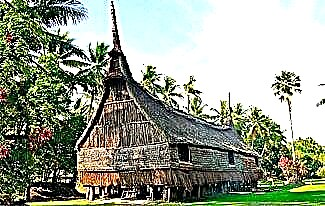Lucrezia Borgia (1480-1519) - the illegitimate daughter of Pope Alexander VI and his mistress Vanozza dei Cattanei, married the Countess of Pesaro, Duchess of Bisceglie, Duchess-consort of Ferrara. Her brothers were Cesare, Giovanni and Gioffre Borgia.
There are many interesting facts in the biography of Lucrezia Borgia, which we will talk about in this article.
So, here is a short biography of the Borgia.

Biography of Lucrezia Borgia
Lucrezia Borgia was born on April 18, 1480 in the Italian commune of Subiaco. Very few documents have survived about her childhood. It is known that her paternal cousin was involved in her upbringing.
As a result, the aunt managed to give a very good education to Lucretia. The girl mastered Italian, Catalan and French, and could also read books in Latin. In addition, she knew how to dance well and was versed in poetry.
Although biographers do not know what the actual appearance of Lucrezia Borgia was, it is generally believed that she was distinguished by her beauty, slender figure and special attractiveness. In addition, the girl always smiled and looked optimistically at life.
An interesting fact is that Pope Alexander VI elevated all his illegitimate children to the status of nephews and nieces. And although the violation of moral standards among representatives of the clergy was already considered an insignificant sin, the man still kept secret the presence of his children.
When Lucretia was barely 13 years old, she was already twice betrothed to local aristocrats, but it never came to a wedding.
Pope's daughter
When Cardinal Borgia became Pope in 1492, he began to manipulate Lucretia, using her for political intricacies. No matter how hard the man tried to hide his paternity, everyone around him knew that the girl was his daughter.
Lucrezia was a real puppet in the hands of her father and brother Cesare. As a result, she married three different high-ranking officials. It is difficult to say whether she was happy in marriage due to the scarce information about her biography.
There are suggestions that Lucrezia Borgia was happy with her second husband, Prince Alfonso of Aragon. However, by order of Cesare, her husband was killed immediately after he ceased to be of interest to the Borgia family.
Thus, Lucretia did not in fact belong to herself. Her life was in the hands of an insidious, wealthy and hypocritical family, which was constantly at the center of various intricacies.
Personal life
In 1493, Pope Alexander 6 married his daughter to the great-nephew of the head of Milan named Giovanni Sforza. It goes without saying that this alliance was concluded by calculation, since it was beneficial to the pontiff.
An interesting fact is that the first months after the wedding, the newlyweds did not live like husband and wife. This was due to the fact that Lucretia was only 13 years old and it was too early for her to enter into a close relationship. Some historians believe that the couple never slept together.

After 4 years, the marriage of Lucrezia and Alfonso was dissolved due to unnecessary, namely in connection with political changes. Dad started divorce proceedings on the basis of consummation - the absence of sexual relations.
During the consideration of the legality of the divorce, the girl swore that she was a virgin. In the spring of 1498 there were rumors that Lucretia had given birth to a child - Giovanni. Among the possible applicants for paternity, Pedro Calderon, one of the pontiff's confidants, was named.
However, they quickly got rid of the likely lover, the baby was not given to the mother, and Lucretia was married again. Her second husband was Alfonso of Aragon, who was the illegitimate sons of the ruler of Naples.
About a year later, Alexander 6's warm relations with the French alarmed the monarch of Naples, as a result of which Alfonso lived separately from his wife for some time. In turn, her father gave Lucretia a castle and entrusted her with the post of governor of the town of Spoleto.

It is worth noting that the girl showed herself as a good steward and diplomat. In the shortest possible time, she managed to try on Spoleto and Terni, who had previously been at enmity with each other. When Naples began to play an increasingly smaller role in the political arena, Cesare decided to make Lucretia a widow.
He ordered to kill Alfonso on the street, but he managed to survive, despite numerous stab wounds. Lucrezia Borgia carefully nursed her husband for a month, but Cesare still did not abandon the idea of bringing the work started to the end. As a result, the man was strangled in his bed.
For the third time, Lucretia went down the aisle with the heir to the Duke of Ferrara - Alfonso d'Este. This marriage was supposed to help the Pope make an alliance against Venice. It is worth noting that initially the groom, along with his father, abandoned Lucretia. The situation changed after Louis XII intervened in the matter, as well as a considerable dowry in the amount of 100,000 ducats.
In the following years of her biography, the girl was able to win over both her husband and father-in-law. She remained d'Este's wife until the end of her life. In 1503 she became the beloved of the poet Pietro Bembo.
Obviously, there was no intimate connection between them, but only platonic love, which was expressed in romantic correspondence. Another favorite person of Lucrezia Borgia was Francesco Gonzaga. Some biographers do not exclude their intimate relationship.
When the legal husband left his homeland, Lucretia was involved in all state and family affairs. She managed the duchy and the castle perfectly. The woman patronized artists, and also built a convent and a charitable organization.
Children
Lucrezia was pregnant many times and became the mother of many children (not counting a few miscarriages). At the same time, many of her children died in early childhood.
The first likely child of the papal daughter is considered to be the boy Giovanni Borgia. An interesting fact is that Alexander VI secretly recognized the boy as his own child. In a marriage with Alfonso of Aragon, she had a son, Rodrigo, who did not live to see his majority.

All other children from Lucretia appeared already in alliance with d'Este. Initially, the couple had a stillborn girl, and 3 years later, the boy Alessandro was born, who died in infancy.
In 1508, the couple had a long-awaited heir, Ercole II d'Este, and the next year the family was replenished with another son named Ippolito II, who in the future became the archbishop of Milan and a cardinal. In 1514, the boy Alessandro was born, who died a couple of years later.
In the subsequent years of the biography, Lucretia and Alfonso had three more children: Leonora, Francesco and Isabella Maria. The last child was less than 3 years old.
Death
In the last years of her life, Lucretia often visited the church. Anticipating her end, she made an inventory of all the utensils and wrote a will. In June 1519, she, exhausted by pregnancy, began premature birth. She gave birth to a premature baby girl, after which her health began to deteriorate.
The woman lost her eyesight and the ability to speak. At the same time, the husband always remained close to his wife. Lucrezia Borgia died on June 24, 1519 at the age of 39.
Photo by Lucrezia Borgia















